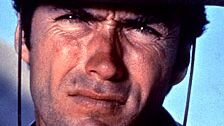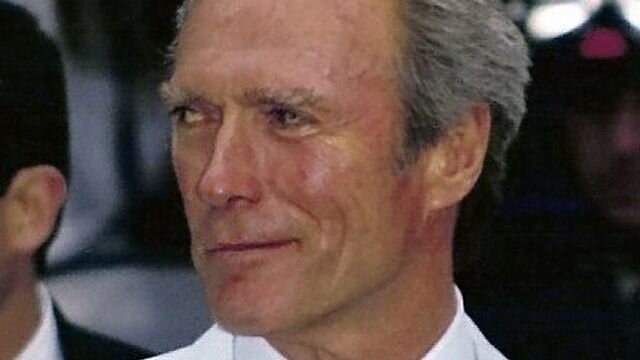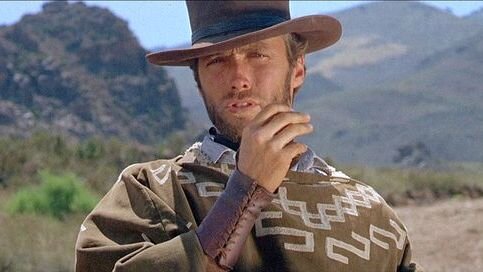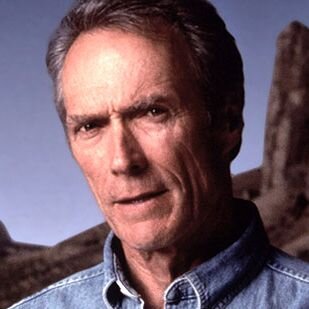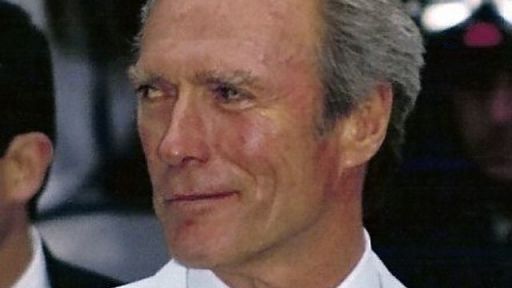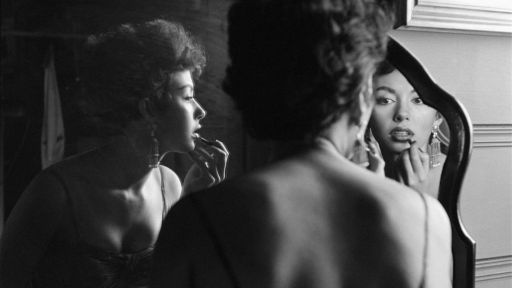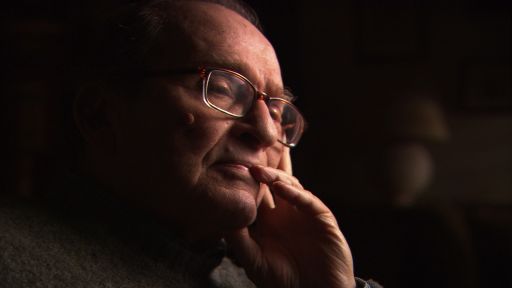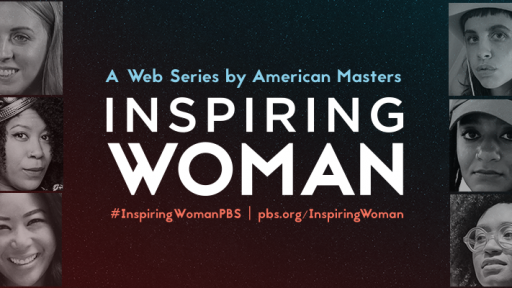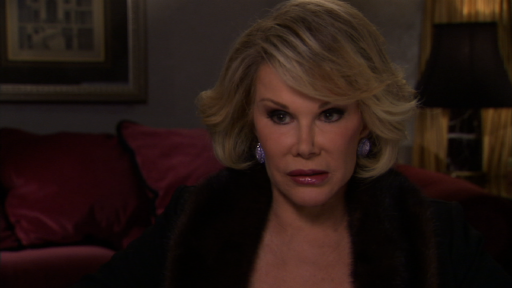Throughout his career as an actor and a filmmaker, Clint Eastwood has practiced a policy of alternation, seldom repeating a tone, a character, or a genre two films in a row.
He follows “Dirty Harry,” the 1971 urban thriller that was his breakthrough to superstar status, with the 1972 “High Plains Drifter,” a defiant return to the Western genre that had given him his start with “Rawhide” and the Sergio Leone films.
He follows the broad slapstick comedy of “Every Which Way But Loose” (1978) with “Escape from Alcatraz,” a terse, tightly focused Don Siegel film that features perhaps Eastwood’s most introverted performance. And he is always careful to follow a personal film, such as 1982’s “Honkytonk Man,” with a more obviously commercial project, such as “Sudden Impact,” as if he were following John Ford‘s old survival technique — making one film for himself, one film for his studio.
But the most significant division in Eastwood’s work lies between the collective, community oriented films — the celebrations of family and belonging, such as “Bronco Billy” and “The Outlaw Josey Wales” — and his studies of reclusive, unfathomable figures like Mitchell Grant in “Firefox,” Charlie Parker in “Bird,” Wes Block in “Tightrope,” or Dirty Harry in all of his incarnations (except, tellingly, for his final, self-parodying appearance in “The Dead Pool,” where he is allowed finally to become part of a group).
As an artist, Eastwood is divided between these extremes of human existence, never definitively choosing one over the other.
The warm glow of community is balanced by the cool breeze of individualism, just as the fear of loneliness is weighed against the resentment of compromise and the burden of unwanted responsibility that are the consequences of social commitment.
This dialogue continues through Eastwood’s most recent films. Luther Whitney in “Absolute Power” (1997) is drawn into reconciliation with his estranged daughter, and turns his skill as a criminal — a cat burglar who always works alone — to working for the public good (the salvation of American democracy, no less). But Steve Everett in “True Crime”(1999) loses his wife and baby daughter, even as he fights successfully to save the life of a man unjustly convicted of murder; at the film’s climax, he is a lonely figure disappearing into the shadows of a shopping mall.
The continuing fascination of Eastwood’s work comes in part from his refusal to make a clear-cut moral choice between social commitment and personal independence. Both options are viewed as equally valid and equally fulfilling — an unusual and provocative position in a film culture where collective values are almost invariably championed over individualism.
Yet it is here that Eastwood approaches one of the fundamental contradictions of American life, the conflict between democratic collectivism and capitalist egoism.
If Eastwood remains impossible to pin down ideologically — despite the facile charges of “fascism” he faced in the 1970s — it’s because he has never forced these values into tidy, artificial reconciliation. The ambivalence runs deep in Eastwood’s work, just as it does in American life.
“Bronco Billy” (1980) is Eastwood’s most optimistic film, a utopian vision of a ragtag community of outsiders and misfits, united by their commitment to the outdated heroic ideals of B westerns. Eastwood himself has described it as his “Capra” film, and it shares Capra’s sense of small town values as the antidote to the soulessness and indifference of big business and big government.
Unlike Capra, however, Eastwood acknowledges that this vision is a childish fantasy — Bronco Billy confesses that he is actually a former shoe salesman from New Jersey who always dreamed of being a cowboy — that poses no real challenge to the established order (neatly symbolized by the train that blithely speeds by, oblivious to the pathetic attempt of Billy and his band to stop and rob it). It is no longer possible to return to these naïve ideals, except at the expense of delusion and regression; Billy and his fellow travelers are portrayed as overgrown children adrift in a world of adults, able at best to find themselves a small, safe corner where they can live out their little dreams.
“Bronco Billy,” like the more complex and mature “The Outlaw Josey Wales,” is structured as a series of additions; new members are accepted into the group, each bringing a particular skill that benefits the community, each representing another subgroup of the socially excluded (among them, significantly, blacks, Indians, women and the elderly). The group is completed when Billy seals his relationship with Miss Lily (Sondra Locke), a skeptical, runaway heiress who is the film’s representative of adult, establishment values; by winning her over, Billy has triumphed, if only temporarily, over reality.
After “Bronco Billy,” Eastwood starred in “Any Which Way You Can,” a sequel to his immensely successful blue-collar comedy “Every Which Way But Loose,” in which his co-star was an orangutan named Clyde. The “monkey movies,” as Eastwood calls them, share the populist values and communal sentiments of “Billy” but avoid its sentimentality and self-consciousness, choosing instead a more vulgar, brawling, anarchic spirit.
Eastwood did not sign his name to either of the monkey movies (the director’s credit went to his long time stunt director, Buddy Van Horn), perhaps an indication that he considered them commercial projects designed to compensate Warner Brothers for accepting the risks of his more personal films. He did, however, sign his next project, “Firefox” (1982), an apparently commercial project (based on a popular novel and packed with “Star Wars”-style special effects) that is actually one of Eastwood’s most personal and eccentric works.
“Firefox” is the anti-“Bronco Billy,” a cold, unyielding film structured as a series of exclusions and escapes. The hero, Mitchell Gant, is perhaps the isolated of Eastwood’s many loners — a former fighter pilot in Vietnam, he has been living in seclusion in the wilderness, haunted by his war experiences and by a particular memory of a young girl burned in a Napalm attack. Gant, in fact, barely seems to exist apart from his one traumatic memory, which Eastwood returns to in repeated, nightmarish flashbacks.
Just as “Bronco Billy” proceeds as a series of additions, “Firefox” is built as a series of subtractions. Gant is slowly stripped of the few elements of social identity he possesses: sent to the Soviet Union a mysterious military agency to steal the prototype of a new, supersonic fighter jet that can defeat radar detection, he is first asked to assume the disguise of an American businessman, then as a Russian worker, and finally as the Soviet fighter pilot who is his opposite number.
As he moves along the stages of his mission, virtually everyone he comes in contact with is killed or sacrificed. His features disappear, first behind a false moustache and a pair of too large glasses; later, and more completely, behind the smoked glass visor of the fighter pilot’s helmet. Dressed in the orange flight suit of the Soviet pilot, he has become physically indistinguishable from him, but this is still not enough. The plane, “Firefox,” is controlled though a futuristic technology that translates the pilot’s thoughts into commands; in order to fly it successfully, Gant must think in Russian, thus giving up the last vestige of his American identity, his private thoughts.
Gant succeeds in stealing the plane, but is pursued by a Russian pilot flying another prototype. He is being chased by his exact double, and the only means of escape is to destroy his pursuer, which means, in effect, destroying himself. At the moment he launches the fatal rocket against his adversary, he is blocked by his memory of the Vietnamese girl; only by definitively repressing it, pushing it completely out of his mind, is he able to think the purely Russian thought that would activate the plane’s defense system.
In purging the memory, he loses every last trace of his self, destroying both his double and any remaining traces of individuality he might still possess. And yet, the film presents this as a happy ending. In the final shot, Gant is reduced to a tiny dot on the screen as he flies away into the distance. Eastwood does not give us the expected triumphant climax, with the plane landing and Gant being applauded by his peers; the triumph, instead, lies in Gant’s final evaporation, in his liberation from himself.
“Honkytonk Man,” Eastwood’s second film of 1982, is another story of disappearance, though this time it is couched in far more humanist terms. The memory theme of “Firefox” is here recycled as nostalgia — nostalgia for a bucolic America of the 1930s, where the poverty produced by the Great Depression seems to serve mainly to bring people together.
Eastwood invested many of his own childhood memories in “Honkytonk Man” — his family, like the family unit in the film, spent much of the 1930s in constant motion, as Eastwood’s father traveled up and down the California coast in search of work. In the film, the family becomes loose, improvised family unit composed of Red Stovall, a gifted but self-destructive country singer (Eastwood), his nephew Whit (played by Eastwood’s son Kyle), and Whit’s grandfather (John McIntire). Whit joins up with Red to escape the suffocating confines of his own family, where he will be doomed to life as a sustenance farmer; he hopes that throwing in with Red will mean adventure and the open road, a chance to create his own identity.
Instead, Whit finds that freedom can mean a life without structure, meaning or human connections. One of the many troubled portraits of artists in the Eastwood canon (“Sudden Impact,” “Bird,” “Escape from Alcatraz,” the episode “Vanessa in the Garden” that Eastwood directed for Spielberg’s TV series, “Amazing Stories”), Red is introverted, taciturn, self-devouring (tendencies represented by the tuberculosis that is eating out his lungs), and is able to communicate only through the medium of his music.
The film’s one moment of group unity is a highly Hawksian sequence in which Red composes the title song riding in the backseat of a car while Grandpa plays the harmonica and Whit contributes a few lines of lyrics. But far more often, Red is a divisive figure who threatens the group with his drunkenness and irresponsibility. His one regret in life is the “raw-boned Oakie girl,” Mary, he seduced away from her husband and then abandoned when she became pregnant; in his boozier moments he allows himself to remember her and try to imagine what his life might have been like if he had stayed with her on a farm.
Like Mitchell Gant, Red Stovall seems to lose pieces of himself as he moves through space; finally, he loses his voice during a crucial audition for the Grand ‘Ol Opry, which costs him his last chance of stardom. Unlike Gant, Red occasionally reaches out, both to Whit and to the woman, Marlene (Alexa Kenin), who renews Mary’s promise of romantic redemption.
Though he is unable to follow through on these gestures, Red does leave something behind when he dies: Whit receives his guitar, and with it, implicitly, his gift for music; Marlene discovers she is pregnant, and perhaps the baby will be Red reborn in a more appropriately dependent form, as the helpless child he has never ceased to be.
“Honkytonk Man” finally eludes both the sentimentality of “Bronco Billy” and the iciness of “Firefox” to establish a somewhat murky middle territory. If it is not as distinctive a work as the other two films, it does clarify the link between them. Intentionally or not, “Bronco Billy,” “Firefox” and “Honkytonk Man” end by forming a trilogy on theme of connection and disconnection, of joining and escaping.
“Sudden Impact,” which followed “Honkytonk Man” in 1983, was no doubt intended to be a potboiler spaced between more personal projects: the fourth “Dirty Harry” film, the project reportedly originated with the Warner Brothers brass and was pressed on a reluctant Eastwood. But in the execution, the film becomes one of Eastwood’s richest works; it is perhaps his neglected masterpiece, a strange, poetic, supremely dark film that achieves a kind of cosmic perspective through its use of bold, primal symbols: the sea, the night, the Unicorn.
Mitchell Gant of “Firefox” met and destroyed his double, and in the process, liberated himself. The Harry Callahan of “Sudden Impact” will have a similar experience, meeting himself in female form as the “Dirty Harriet” played by Sondra Locke, though the outcome is radically different. Locke’s character, Jennifer Spencer, is an artist divided against herself: at night, she paints tortured, expressionistic self-portraits, which she shows in a San Francisco gallery; during the daylight hours, she is a professional restorer of merry-go-round horses, which she brightens and brings back to life.
But Jennifer’s real business in life is seeking revenge for the gang rape she and her younger sister suffered beneath a boardwalk in the California resort town of San Paulo. With her sister in a permanent traumatic coma, Jennifer has tracked down the men who participated in the rape and has begun killing them one by one, shooting them in the genitals and then in the head.
The Harry Callahan of “Sudden Impact” has mellowed considerably since “Dirty Harry.” Though he still carries on his one-man war against the scum of San Francisco, he is less liable to employ indiscriminate violence. He is now a tightly controlled, almost emotionless figure, who uses language, not bullets, to assassinate a crime boss who has eluded legal prosecution (breaking into the man’s daughter’s wedding, he threatens him convincingly enough to give the man a heart attack).
When Harry is attacked by a group of the crime boss’s vengeful bodyguards, Eastwood contrasts their sloppy, excessive violence — they pump a few hundred rounds of automatic weapon fire into a dumpster in which they think Harry is hiding — against the detective’s pinpoint accuracy and perfect control (the three hoods require precisely three bullets). If his rage is still there, it is now disciplined and focused; his crusade against the “scum of the city” is no longer personal, but something professional and detached, institutionalized and permanent.
He now embodies the law as a theoretical, rational force, rather than as a passionate avenger.
Sent from San Francisco to San Paulo to investigate the first of Jennifer’s castration killings, Harry meets on a jogging path without knowing that she is the murderer; he picks her up again in an outdoor restaurant, and they bond over their shared sense of the inadequacy of the legal system (“I bet you’re tired of hearing that” “Actually, I don’t hear it enough”). But what seems at first to be common ground — has Harry actually found a love interest, to replace the long-dead wife whose murder, pre-“Dirty Harry,” touched off his rage? — turns out to be another gulf of separation. He believes in revenge, Harry says, until it breaks the law.
Harry is all retention, repression, control — like the law itself, he is inflexible and distant, a dispassionate instrument of justice. Jennifer’s rage is personal, but it also has a timeless, ancient quality. She seems to be standing in for all of the women, from “Coogan’s Bluff” to “High Plains Drifter,” who were raped in Eastwood films, sometimes for comic effect. Unlike Harry’s, her violence is not focused and disciplined, but excessive (the unnecessary second shot) and impulsive. Eastwood plays with the traditional “justice is blind” imagery by emphasizing shots of himself wearing absurdly large, wrap-around sunglasses; Locke, on the other hand, is generally shot with an emphasis on her huge, watery eyes, which almost seem ready to burst from her head. The portraits she paints of herself are all eyes and mouth, screaming cavities at once vulnerable and horrifying.
“Sudden Impact” brings Harry 180 degrees from his original incarnation. He is now the standard-bearer of social values, of law and order over open warfare. Jennifer is the old Harry, and he recognizes her and is frightened by her. Eastwood consistently associates water imagery with Jennifer (the rape takes place by the sea, as do most of her revenge killings), linking her to forces that are large, ancient, fecund and traditionally female. Harry has been given nothing better than a newer, bigger Magnum to port around, just another tin-toy penis in a world that already seems full of them.
Harry is stripped of his gun and pitched into the ocean by the thugs Jennifer is searching for; he is left for dead but (in what has become a favorite Eastwood image) is symbolically reborn when he pulls himself out of the water and emerges on shore. From this point on in the film, he shares in Jennifer’s passion.
The great chase and gun battle that follows ends with the principle heavy impaled on the horn of a wooden unicorn — a traditional symbol of virginity that also has obvious phallic overtones. The imagery is hopelessly confused, as is Harry — who, now aware of Jennifer’s guilt, impulsively decides to protect her from prosecution. Perhaps this is love, or at least as close as Dirty Harry is able to come to it. But whatever it is, it has required Harry to abandon his most sacred principle — that murder must be punished — and let a perpetrator walk away. His communal values have become irrevocably personal.
The film’s final image is a helicopter shot of the bay surrounding the amusement pier where the final confrontation takes place — a phallic promontory dwarfed by the immensity of the ocean. There is a sense of provisional reconciliation, of a fragile, temporary peace — a peace that Harry has achieved by abandoning his principles and with them, his sense of himself.
As a benumbed Harry leads Jennifer away at the end of the film it is difficult to believe that this relationship has much of a future (it feels almost regressive, as if Harry had taken up with the equally vengeful, equally psychotic Evelyn Draper (Jessica Walter) of Eastwood’s first film as a director, “Play Misty for Me” (1971). For Eastwood, who fully intended “Sudden Impact” to be the last of the “Dirty Harry” films (before he was coaxed into making “The Dead Pool” in 1988), this must have seemed a fittingly final farewell to the character. Harry has finally been beaten, not by a criminal, but by a more ferocious, more feral, more female version of himself. Once again, an Eastwood hero vanishes into the darkness.

